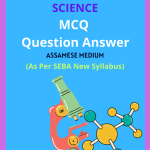Class 7 Science MCQ Chapter 16 Water: A Precious Resource Solutions in English Medium, Class 7 Science Multiple Choice Question Answer in English to each chapter is provided in the list so that you can easily browse throughout different chapters Class 7 Science MCQ Chapter 16 Water: A Precious Resource Notes and select need one.
Class 7 Science MCQ Chapter 16 Water: A Precious Resource
Also, you can read the SCERT book online in these sections Class 7 Science Objective Type Solutions by Expert Teachers as per SCERT (CBSE) Book guidelines. These solutions are part of SCERT All Subject Solutions. Here we have given Assam Class 7 Science MCQs Solutions in English for All Subject, You can practice these here.
Water: A Precious Resource
Chapter – 16
| MCQ |
1. Which of the following is not an effect of acute scarcity of water in plants?
(a) Shortage of food.
(b) Shortage of oxygen.
(c) Shortage of carbon dioxide.
(d) Shortage of rainfall.
Ans: (c) Shortage of carbon dioxide.
2. What is an effective measure to address water scarcity?
(a) Increasing the water cycle.
(b) Using water economically.
(c) Reducing population growth.
(d) Expanding industrial activities.
Ans: (b) Using water economically.
3. The minimum amount of water recommended by the United Nations per person per day is:
(a) 25 L.
(b) 50 L.
(c) 75 L.
(d) 40 L.
Ans: (b) 50 L.
4. Which of the following should be avoided to conserve water?
(a) Regular maintenance of pipes.
(b) Using water economically.
(c) Overdrawing from groundwater.
(d) Fixing leaking taps.
Ans: (c) Overdrawing from groundwater.
5. The water-bearing layer of the earth is called:
(a) Conifer.
(b) Hydrosphere.
(c) Aquifer.
(d) Water table.
Ans: (c) Aquifer.
6. In how many forms does water exist?
(a) One.
(b) Two.
(c) Three.
(d) Four.
Ans: (c) Three.
7. Groundwater will not be depleted due to:
(a) Afforestation.
(b) Thermal power plants.
(c) Loss of forest and decreased rainfall.
(d) Cropping of high water-demanding crops.
Ans: (a) Afforestation.
8. What is one major cause of water scarcity?
(a) Low population growth.
(b) Efficient irrigation practices.
(c) Rapid growth of industries.
(d) Reduced industrial activity.
Ans: (c) Rapid growth of industries.
9. The main source of water in India is:
(a) Rainwater.
(b) Groundwater.
(c) Surface water.
(d) Sea water.
Ans: (a) Rainwater.
10. What happens to plants if they are not watered for a few days?
(a) They thrive.
(b) They remain unchanged.
(c) They wilt and dry up.
(d) They grow faster.
Ans: (c) They wilt and dry up.
11. Water which falls from the clouds as rain or snow is called:
(a) Condensation.
(b) Precipitation.
(c) Infiltration.
(d) Transpiration.
Ans: (b) Precipitation.
12. Out of the following, which year was observed as the International Year of Freshwater?
(a) 2005.
(b) 2003.
(c) 2006.
(d) 2008.
Ans: (b) 2003.
13. Sea/ocean water cannot be used for domestic use because it contains:
(a) Soluble salts.
(b) Dust.
(c) Insoluble salts.
(d) Acids.
Ans: (a) Soluble salts.
14. The solid form, snow and ice, is present ___________ of the earth.
(a) At the poles.
(b) At the equator.
(c) Present in the atmosphere of the earth.
(d) In the oceans.
Ans: (a) At the poles.
15. Which of the following increases the rate of percolation of rainwater into the soil?
(a) Constructing check dams.
(b) Vegetation and trees.
(c) Overgrazing.
(d) Construction of roads.
Ans: (a) Constructing check dams.
16. Depletion of the water table is due to:
(a) Increase in population.
(b) Industrial and agricultural activities.
(c) Scanty rainfall.
(d) All of the above.
Ans: (d) All of the above.

Hi! my Name is Parimal Roy. I have completed my Bachelor’s degree in Philosophy (B.A.) from Silapathar General College. Currently, I am working as an HR Manager at Dev Library. It is a website that provides study materials for students from Class 3 to 12, including SCERT and NCERT notes. It also offers resources for BA, B.Com, B.Sc, and Computer Science, along with postgraduate notes. Besides study materials, the website has novels, eBooks, health and finance articles, biographies, quotes, and more.



